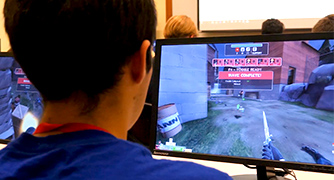Accessible Videos in Brightspace
There are many ways to get video content for your course. You can find videos from YouTube, use your Zoom meetings recordings, use Panopto recordings that you have created, or have been placed in your Panopto site from Zoom. Captioning is critically important. This allows the hearing impaired to read the words spoken in the video.
Search for YouTube captioned Videos:
When choosing videos, make sure they have accurate captions.
When searching through Youtube, add ", CC" after your search terms. Or filter the YouTube search :
- Enter your keywords in the YouTube search bar and click Search.
- Click Filter filter results.
- Click Subtitles/CC.
- Videos with captions available will have “CC” underneath the video summary in search results.
When using Google searches, select the Google Advanced Video Search and select "closed-captioned only" from the subtitles menu.
Or Create captions in your uploaded videos in Panopto (see the video below):
Find step-by-step instructions with screenshots are available on the Panopto Support pages.
For more information about using Panopto for creating and hosting videos in your class, please visit the Panopto Page.
Best Practices for Video
- Adding music to the video is best kept to the introduction and finale. Many find that music playing while someone is talking in videos makes the content harder to comprehend.
Accessibility Tips and Tricks:
Here are some tips for ensuring that course materials, notes, and other information resources are engaging, flexible, and accessible for all students:
- Select materials early.
- Choose materials and prepare a syllabus early to allow students the option of beginning to read materials and work on assignments before the course begins and time to arrange for alternative formats.
- Consider audiobooks and e-books.
- Choose materials and prepare a syllabus early to allow students the option of beginning to read materials and work on assignments before the course begins and time to arrange for alternative formats.
- Provide content in an accessible, universally designed formats.
- Select or create materials (including textbooks, syllabi, lesson pages, presentation materials) that are universally designed. For example, use electronic materials that are text-based, have flexible features, use formatted headings and lists, describe the content within images, have consistent layouts and organization schemes, whose link text describes its destination, use large sans serif fonts on uncluttered pages with plain backgrounds, and incorporate color combinations that are high contrast and can be distinguished by people with color blindness. Use captioned videos and provide transcriptions for audio presentations. Apply accessibility standards to websites.
- Accommodate a variety of reading and technology, skills.
- Present content in a logical, straightforward manner and in an order that reflects its importance. Avoid unnecessary jargon and complexity and define new terms when they are presented. Create materials in simple, intuitive formats. Provide options for gaining the technical skills needed for course participation. Share relevant campus resources with students.
- The Marist University Office of Accommodations and Accessibility supports students with documented disabilities in becoming empowered, independent learners by providing the appropriate accommodations and services necessary to access the educational opportunities at Marist College.
- Tools to consider Read Speaker
Accessible Course Overview:
Sheryl Burgstahler, the director of Accessible Technology Services within UW-IT and affiliate professor in the College of Education at the University of Washington, shared this wealth of information in January 2017 Educause Article, "ADA Compliance for Online Course Design."
With references to in-depth resources for some of the topics — that can help online instructors make their courses accessible to a broad audience: "20 Tips for Teaching an Accessible Online Course." Although the tips do not cover every potential accessibility issue, they provide a good start.
Washington University has shared tips and tricks for course web pages, documents, images and videos:
- Use clear, consistent layouts and organization schemes for presenting content.
- Structure headings (using style features built into the learning management system, Word, PowerPoint, PDFs, etc.) and use built-in designs/layouts (e.g., for PPT slides).
- Use descriptive wording for hyperlink text (e.g., "DO-IT Knowledge Base" rather than "click here").
- Minimize the use of PDFs, especially when presented as an image; make sure the text is accessible by testing to see if you can copy and paste it. Always offer a text-based alternative as well.
- Provide concise alternative-text descriptions of content presented within images.
- Use large, bold fonts on uncluttered pages with plain backgrounds.
- Use color combinations that are high contrast and can be read by those who are colorblind.
- Make sure all content and navigation is accessible using the keyboard alone.
- Caption or transcribe video and audio content.
Benefits of Accessible Design for Individuals without Disabilities
Students in a class can vary by gender, race, ethnicity, culture, marital status, age, communication skills, learning abilities, interests, physical abilities, social skills, sensory abilities, values, learning preferences, socioeconomic status, religious beliefs, and other factors. Many of these individuals might never request a disability-related accommodation but will nevertheless benefit from accessible design. For example, many English language learners benefit from captions on videos so that they can see the spelling of new vocabulary. Other students learning new vocabulary in a technical class can benefit from these captions as well. And everyone benefits from course content that is presented in a logical, consistent manner.

Accommodations and Accessibility
The Office of Accommodations and Accessibility provides a comprehensive range of academic support services and accommodations that promote the full integration of students with disabilities into the mainstream college environment. Services and accommodations are individualized to meet the needs of each student and may vary depending upon the disability and/or course content.
Contact Us
If you have any questions or need further assistance with the tool, please don’t hesitate to contact us at 845-575-3572.
